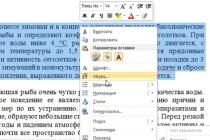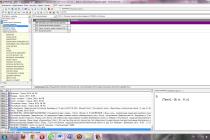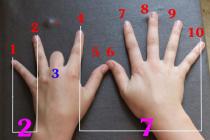Good hour.
Today, Wi-Fi is available in almost every apartment that has a computer. (even providers, when connecting to the Internet, almost always set Wi-Fi router even if you only connect 1 stationary PC).
According to my observations, the most frequent problem with the network for users, when working with a laptop - this is to connect to Wi-Fi networks... The procedure itself is not complicated, but sometimes, even in new laptops, drivers may not be installed, some parameters that are necessary for full network operation may not be set (and due to which the lion's share of the loss of nerve cells occurs :)).
In this article I will take a step-by-step look at how to connect a laptop to some kind of Wi-Fi network, and so I will analyze the main reasons why Wi-Fi may not work.
If the drivers are installed and the Wi-Fi adapter is on (i.e. if everything is fine)
In this case, in the lower right corner of the screen, you will see the Wi-Fi icon (without red crosses, etc.). If you click on it, Windows will inform you that there are available connections (i.e. it found a Wi-Fi network or networks, see the screenshot below).
As a rule, in order to connect to the network, it is enough to know only the password (we are not talking about any hidden networks now). First, you just need to click on the Wi-Fi icon, and then select the network to which you want to connect from the list and enter the password (see screenshot below).
If everything went well, you will see a message on the icon that you have access to the Internet (as in the screenshot below)!
by the way, if you are connected to a Wi-Fi network, and the laptop says that "... there is no access to the Internet," I recommend that you read this article:
Why is there a red cross on the network icon and the laptop does not connect to Wi-Fi ...
If not everything is in order with the network (more precisely, with the adapter), then on the network icon you will see a red cross (as it looks in Windows 10 is shown in the photo below).
On some laptops, by the way, there are special keys for turning on the Wi-Fi adapter (these keys usually have a characteristic Wi-Fi icon). Examples:
- ASUS: press the combination of FN and F2 buttons;
- Acer and Packard bell: FN and F3 buttons;
- HP: Wi-Fi turns on touch button with a symbolic image of the antenna. On some models, the shortcut keys: FN and F12;
- Samsung: FN and F9 buttons (sometimes F12), depending on the device model.
If you don't have dedicated buttons and LEDs on the device case (and those who have it, and the LED does not light up), I recommend opening device Manager and check if there are any problems with the driver for the Wi-Fi adapter.
How to open device manager
The easiest way: open the panel Windows management, then write the word "dispatcher" into the search box and select the desired one from the list of found results (see the screenshot below).
In Device Manager, notice two tabs: “ Other devices"(There will be devices for which no drivers were found, they are marked with a yellow exclamation mark), and on" Network adapters"(There will be, just, the Wi-Fi adapter, which we are looking for).
Pay attention to the icon next to it. For example, the screenshot below shows an icon for a device that is turned off. To enable it, you need to right-click on the Wi-Fi adapter (note: Wi-Fu adapter is always marked with the word "Wireless" or "Wireless") and activate it (thus it turns on).
By the way, pay attention, if an exclamation mark is on against your adapter, it means that the system does not have a driver for your device. In this case, you need to download and install it from the device manufacturer's website. You can also use the specials. driver search applications.
There is no driver for Airplane Mode Switch.
Important! If you have problems with the drivers, I recommend that you read this article:. With it, you can update drivers not only for network devices, but also for any others.
To do this, press the Win + R key combination and type ncpa.cpl, and press Enter (in Windows 7, the Run menu has a md START menu).
Next, a window will open with all network connections. Pay attention to the connection named "Wireless Network". Turn it on if you have it turned off (as in the screenshot below. To enable it - just right-click on it and select “enable” in the pop-up context menu).
I also recommend to go to the properties of the wireless connection and see if the automatic obtaining of an IP address is enabled. (which is recommended in most cases)... First open the properties of the wireless connection (as in the picture below)
Then set the automatic acquisition of the IP address and DNS server. Save and restart your PC.
Wi-Fi managers
Some laptops have special managers for working with Wi-Fi (for example, I came across these in HP laptops. Pavilion, etc.). For example, one of these managers .
The bottom line is that if you don't have this manager, Wi-Fi is almost impossible to run. I don’t know why the developers are doing this, but you want it or not, and the manager will need to be installed. As a rule, you can open this manager in the START menu / Programs / All programs (for Windows 7).
The moral here is: check on the official website of your laptop manufacturer to see if there is such a recommended manager for installation among the drivers ...
Network diagnostics
By the way, many are neglected, but Windows has one good tool for troubleshooting network problems. For example, somehow for a long time I struggled with the incorrect operation of the airplane mode in one laptop from Acer (It turned on normally, but to disconnect, it took a long time to “dance.” So, in fact, he got to me, after the user could not turn on Wi-Fi after such a flight mode ...).
So, to get rid of this problem, and many others, such a simple thing as troubleshooting (to call it, just click on the network icon).
Next, the Windows Network Diagnostic Wizard should start. The task is simple: you just need to answer the questions, choosing one or another answer, and the wizard will check the operation of the network and correct errors at each step.
After such a seemingly simple check, some of the network problems will be resolved. In general, I recommend giving it a try.
This is the end of the article. Have a nice connection!
It is clear without question that you cannot turn on Wifi on your hp 620, 4535, 655, Pavilion g6, dv6, g7, dv7, g62, g series, p157nr, Probook 4525s, 4530s, 4520s or any other laptop.
Do not worry, regardless of the OS: windows 7 or windows 8 - now we will quickly solve this problem.
What you need to do to enable wifi on your hp pavilion laptop or Probook.
The first and most important step is to make sure that you have the wifi driver installed.
How to check? You can either use the method described below.
NOTE: very efficient way find out why the Internet does not work via wi-fi do a diagnosis -
How to check if wifi driver is installed in HP laptop
Open and click on the left side, on the set of words: "Change adapter parameters."
If you see that you have a "Wireless Network Connection" adapter displayed (as in the picture below), and 5 more bars in green, it will be great. If it is gray, then click on it with the right mouse and click on the line "enable".
If you don't see a wifi adapter there, then we download the wifi driver, specifically for your hp laptop model.
Enabling wifi on hp laptops with the buttons and keys on the keyboard
Manufacturers very often on laptops, in particular HP, install special buttons on the case to turn on and off the wifi interface.
In older models, look for the button with the antenna icon above the keyboard, then press and hold it. In the new ones, this button is below the keyboard and also on the left side.
If you did not find it, carefully examine the keyboard to see if there is a key with an antenna icon on it.
If found, then hold down the fn key and press it until the wifi turns on.
In general, the reasons why wifi will not turn on can be much more than described above - it can be disabled in the BIOS, the module itself fails, something with services, and so on, only this is another topic. Good luck.
In this article, we will show you how to turn on wifi on a laptop. The fact is that on laptops of different brands and manufacturers, Wi-Fi is also turned on differently. On some laptop models, you need to turn on a mechanical switch, on others, just press the desired keyboard key combination.
Therefore, our article will be split into two parts. In the first part we will tell you about turning on WiFi on different models laptops, and in the second part we will consider some of the features of enabling Wi-Fi in the Windows operating system. So let's go!
Below we list the standard laptop keyboard shortcuts that enable Wi-Fi on a laptop. Do not forget, as mentioned above, that some models have a mechanical switch / switch that is responsible for turning on the laptop's WiFi.
You can always clarify this moment by asking a question in the comments. Now, we will move on to the keyboard shortcuts for the laptop, which are designed to enable wifi. Usually the button on a laptop that is responsible for turning on the wireless network is marked with a stylized icon:

- Let's start with the company's laptops Asus (Asus)... To turn on Wi-Fi on them, use the key combination Fn + F2.
- The company's laptops HP (Hewlett Packard) need to clamp Fn + F12. Or find the button with the image of the wireless network.
- Laptops Acer and Packard bell turn on WiFi using a keyboard shortcut Fn + F3.
- On laptops MSI WiFi is turned on with the keys Fn + F10.
- On laptop models from Samsung need to clamp Fn + F9 or Fn + F12 .
- Laptops from Lenovo, depending on the model, may have a dedicated switch. Also, turning on the wireless network can be through a key combination Fn + F5.
- On laptops from Toshiba (Toshiba) the keyboard shortcut should be used Fn + F8.
- Laptops from Sony Vaio(Sony Vayo) may have a mechanical switch.
With no button Fn it makes sense to look for a switch on the side of your laptop. If, after turning on using the keys or a switch, WiFi did not work, then perhaps the reason lies in setting up the Windows operating system, the configuration of which will be described later.
Software enable Wi-Fi on laptops
Some laptop models may have software through which the WiFi adapter is turned on. For example, on laptops Samsung this program is called “Easy Settings”, and on laptops with Wi-Fi adapters from the company Intel the “Intel PROSet” program is installed. This fact undoubtedly needs to be taken into account, especially if you have not found hotkey there is no mechanical switch on the keyboard and on the laptop.

If such software is installed on your laptop, then the Wi-Fi network is turned on through this software.
How to turn on wifi on a computer
For those of you, dear visitors, who do not have a laptop, but want to turn on Wi-Fi on a stationary computer, we want to make a small explanation. The fact is that not everyone has a built-in Wi-Fi module that allows you to communicate via wireless technology... Find out if there is computer WIFI the module can be from the specification to your motherboard or try to find the adapter in Windows Device Manager.

As you can see from the screenshot above, the Wi-Fi adapter contains the word “Wireless”. Also, the module may contain the word “WiFi”. As you probably already understood, without such an adapter, you will not be able to connect to a wireless access point or router. There is a variety of equipment on sale, Wi-Fi adapters and modules for every taste and wallet. They can be divided into two main types - USB and PCI adapters. The picture below shows a PCI module for connecting to Wi-Fi:

Respectively USB adapter inserted into USB connector on the motherboard, and the PCI adapter plugs into the pci slot of the motherboard. After installing the drivers, such an adapter can be fully used. Let's move on to the settings that are responsible for Wi-Fi in your operating system.
Turn on WiFi in Windows
There are a number of options that you need to check in order for WiFi to work. To get started, go to the device manager (“Control Panel”> “System”> “Device Manager”) and check if everything is in order with the network adapter driver. The device should not have a yellow exclamation mark, and it should be enabled, as shown in the next picture (we will talk about configuring the adapter in Device Manager below).
Next, you need to check if the one we need is enabled. wireless connection... To do this, visit “Control Panel”> “Network and Internet”> “Network Connections”. The following picture shows the wireless connection is not enabled. If you also do not use it, then you need to turn it on by clicking on it with the right mouse button.

In addition, you should make sure that your laptop sees the access point or router and connects to this device. By the way, we advise you to read the article:. So if WiFi router visible, then in Windows tray(in the lower right corner there is a ladder icon) you need to select it and click the "Connect" button to the desired Wi-Fi network.

After that, it is enough and WiFi network will work.
If WiFi on laptop won't turn on
Here we decided to give a short instruction if Wi-Fi does not want to turn on in any way, although the required key combination seems to have been pressed. First of all, make sure that the adapter, which we talked about above, is involved in the device manager.

It may also happen that the driver for the adapter is not installed. In this case, you need to go to the laptop manufacturer's website, find the section for downloading drivers and download required driver for WiFi module. If you already have a driver (for example, on a driver disk that came with the laptop), then you can install it manually by specifying its location:

Next, you need to make sure that your wireless router turned on and running. If the router is turned on, then it can be disconnected for a while (for about half a minute) and turned on again. You can check the WiFi network using your mobile phone or tablet computer if you have one at hand.
If the gadget finds a network and connects to it, then the problem is in the laptop. If you have problems turning on WIFI, we also advise you to read our other article if. That's all, we hope that our instructions on how to turn on wifi on a laptop turned out to be useful. If you still have questions and the problem has not been resolved, then you can always ask a question in the comments. Finally, watch a short video on how to set up Wi-Fi on a laptop:
Today it is difficult to imagine a modern apartment or even more so an office not equipped with the appropriate set of office equipment: computers, laptops, tablets, mobile phones. And where all these devices are available, the Internet should naturally also be available. He firmly entered our life, occupying one of the most prominent places there. On the Internet, we study, work, have fun, relax, communicate. Therefore, the comfortable provision of access to the World Wide Web for yourself and your loved ones is a problem that sooner or later each person has to solve. Fortunately, now we have a reliable assistant that allows us to carry out the most effective and simple solution to this issue without special additional intellectual and financial costs. This is, of course, about Wi-Fi technology.
But in order to use the "air" Internet, you need to know where to find and how to enable Wi-Fi on your computer. We have tried to explain the answers to these questions in the current article.
What is Wi-Fi?
Technology wireless internet became a part of our everyday life. We habitually identify Wi-Fi with convenient, reliable and fast Internet access, which we encounter at home, at work, in public places - at airports, cafes, shopping centers.
Answer the question "what is Wi-Fi?" the simplest way is: it is a network protocol, with the participation of which communication is carried out between an "access point" and a "client", or an "access point" and several "clients", packet data is exchanged in local network or through the World Wide Web.

Currently, the abbreviation Wi-Fi does not mean anything and is not officially deciphered in any way, however, when creating this protocol, the developers "gave it a name" by analogy with Hi-Fi (High Fidelity). It stood for "Wireless Fidelity" - wireless fidelity.
Benefits of using
Of course, the "air" Internet is not an ideal technology. Several examples can be given at once of what difficulties may arise when using it. One of the most widely known is the so-called “noisy” connection. In the range used by this protocol, many household appliances (for example, microwave ovens) emit, operate alternative devices connections (e.g. Bluetooth). Walls and floors can also create interference. All this negatively affects the speed and quality of access.

At the same time, there are no less positive aspects from using it in home and office conditions. Here are just some of the most obvious ones:
- Low cost wireless networking and multiple access points that provide consistent coverage across the entire territory. At the same time, there are no cables, extension cords and adapters that constantly get confused and clutter up the space. "Air" connection is indispensable in premises of historical value, as well as in premises with obstructing architectural features;
- This protocol provides full access to the Internet for any device - be it mobile phone, tablet, laptop or stationary computer - without being tied to a specific place. Going out to the world information space through this protocol, it is an opportunity to comfortably use the Internet while lying on your favorite couch;
- Wi-Fi allows you to synchronously use a large number of active connections. By setting wireless connection, you may not care about how many computers and mobile devices will simultaneously go online.
What are the types of Wi-Fi modules for a computer?
All popular devices are now equipped with adapters by default. They can be connected to the Internet out of the box, but what about those with a stationary computer? The answer to this question is obvious - you need to purchase an additional Wi-Fi receiver, install, connect and configure it.
We'll talk more about how to install Wi-Fi on a computer below. Now we propose to determine what receivers are, what is their difference, specificity and advantages.

Air adapters are of two types: external and internal. External are the most commonly used and easier to operate. An external receiver is like a miniature USB drive (flash drive). It connects to the USB connector on the front or back of the computer, either directly or via a USB cable.

The internal adapter is slightly larger and requires opening the computer case to install it. Therefore, only buy an internal receiver if you are confident you can figure out how to install it on your motherboard yourself. When installing the internal module, you must first disconnect the antenna from it, insert the board into the corresponding port on the motherboard (for this, the PCI interface is most often used) and return the antenna to its place.
Further manipulations for installing and turning on wireless adapters do not differ and do not depend on the modification and method of connection to the computer.
How do I install the drivers?
Any Wi-Fi receiver is equipped with a disc from the manufacturer, which contains the drivers necessary for the full operation of the device. In addition to drivers for specific device, the disk may also contain drivers for other adapter models, so during installation you need to be careful not to miss the choice of the device for which the drivers are installed.

The rest of the driver installation procedure is standardized and provided with an intuitive interface with detailed prompts from the Found New Hardware Wizard. Just carefully read the messages that will appear on the screen, and click the corresponding buttons "Next", "OK" and "Finish".
Most adapters are automatically recognized by current computers and can work even without installing the drivers from the bundled CD. It is enough to connect the device to the required connector and wait a few seconds. As a rule, after that, a message will appear in the "tray" stating that new equipment has been found, identified and installed, which is already ready for use. Nevertheless universal drivers cannot completely replace specialized software. Therefore, we advise you not to neglect the installation of drivers, even if everything works flawlessly at first glance.
The driver disk for your model of the Wi-Fi receiver may also contain special utility from developers, which is designed to facilitate the process of setting up Internet access. Moreover, this utility will allow you to further control your Internet connection, monitor the speed and volume of data transfer.
How to set up Wi-Fi in WIN XP?
For this guide, we will assume that your home AP and tethering device are already configured.
So, in order to establish an "air" connection on a computer running Win XP OS, you need to do the following:
- Open the "Start" menu;
- Select "Network Neighborhood";
- In the "Network Connections" window, find the "Wireless Network Connection" icon;
- Right-click on the icon and click "Properties" in the list;
- In the "General" tab, find the item "Internet Protocol TCP / IP";
- Click the "Properties" button.
If it is critical for your provider to use specific ip and dns addresses, then in the window that opens, check the "Use the following ip address" radio button. If these parameters are configured in your automatic mode then don't touch anything.

At manual setting ip, you need to fill in the following fields:
- IP address: 192.168.0.2 (You should check this parameter with your ISP, the value may be different);
- Subnet mask: 255.255.255.0;
- Enter the address of your router or modem in the line "Main gateway", usually it is 192.168.0.1 or 192.168.1.1. But in order to avoid mistakes, it is better to check the documentation of your device;
- Click to activate the "Use the following DNS server addresses" radio button and fill in both the primary and secondary DNS server fields. Information about the DNS servers used by the provider can be found on the official website of the telecommunications company or by calling technical support;
- Without closing this window, select the "Wireless Networks" tab at the top and select the "Use windows to configure the network" checkbox in it. Then press the button "Wireless networks". Here you will see a list of all available connections. Select the connection that is configured on your dispenser and click the "Connect" button. Now, in order to connect to the Internet, it remains to enter the username and password you know.
How to set up Wi-Fi in WIN7?
There are two ways to set up an "air" connection in Win7 OS: in automatic mode and manually. The second option may be useful if the network to which you plan to connect is hidden from the general list for security reasons, but you know the name and password to connect your computer to it. Let's consider both methods step by step.
Installing Wi-Fi in Win7 OS in automatic mode
When the operating system is loaded, you can see the "Wireless Network Connection" icon in the lower right corner of the screen. Click on it. This will open a list of "air" connections available to you. you need to choose from the list the one that is configured in your modem or router.

Installing Wi-Fi in Win7 OS in manual mode
To configure the connection manually, select "Network" in the system tray, then "Network Control Center and general access". Click "Setting up a new connection or network." At the next stage, we mark the parameter "Connect the wireless connection manually" and click the "Next" button.
In the next dialog, fill in all the appropriate fields: specify the network name, encryption type and security level. In most cases, the default settings can be left unchanged - use AES and WPA2. In the "Security Key" field, you must enter the password for the connection. For more security, check the "Hide characters" box so that the password cannot be read because of your shoulder.

The final touch - if you plan to use this connection as the main one in the future, then check the box "Start this connection automatically". Then click the "OK" button.
Installing the device in Windows 8
To connect wirelessly in Win8, do the following:
- Click on the Wi-Fi icon in the system tree on the taskbar or call Settings Charm through the Charms Bar (similar to pressing the win + I combination). The Wi-Fi panel will appear on the right side of the screen;
- you will see the entire list of wireless networks available for connection. Select the one that is configured for you and click the "Connect" button;
- The next step is to check the conditions for connecting to the network. The system will check the requirements of the selected network and offer to enter the required data;
- After checking the network requirements, the system will prompt you for a password. Enter the security key you know and click "Next";
- If the password is entered correctly, you will see the message "Connection complete", which means that the connection to the Internet has been established.
How do I disconnect the device?
To turn off Wi-Fi or edit the previously entered data, select the wireless networks icon in the tray (relevant for Win7 and Win8) and select the one that you configured earlier in the drop-down list of all available connections. To disable, use the Disable button, and to edit - right-click and click Properties. In the "Connection" and "Security" tabs, you can either disconnect the device or make changes to the password, encryption type or security level.

For Win XP, you need to do the following:
- Start menu;
- Network Neighborhood icon;
- "Wireless connection";
- In the list that opens, select established connection and click the "Disable" button.
Most laptops are equipped with a built-in module that provides an internet connection. They make it possible to connect an external device for this. Wireless technologies have become widespread among users of various levels due to their convenience and practicality. But sometimes standard methods link activations do not work.
Before you enable Wi-Fi on your laptop, you should be aware of the methods as well as possible reasons problems to fix them.
Checking the operation of the hardware Wi-Fi module on a laptop
To check for a module wireless communication in a laptop, you need:
- Go to the control panel.
- In the device manager go to the "Network adapters" section. If there is a name Wireless in the list of devices, then a WiFi connection module is built into the technique.
To turn on Wi-Fi on some laptop models, you need to find a slider or a special button on the device.
 This activation method is mostly common on older models. If there is no built-in switch, then you need to pay attention to the laptop keyboard. The function keys F1-F12 have quick action buttons. They allow you to adjust the sound volume, screen brightness, activate airplane mode, and turn the wireless module on or off.
This activation method is mostly common on older models. If there is no built-in switch, then you need to pay attention to the laptop keyboard. The function keys F1-F12 have quick action buttons. They allow you to adjust the sound volume, screen brightness, activate airplane mode, and turn the wireless module on or off. 
To initiate a wireless connection, inspect the function buttons. One of them should have an antenna symbolizing Wi-Fi. On laptops from different manufacturers, the keys may differ. But in most cases, the Fn button will activate the function button when pressed simultaneously. It is located at the bottom of the keyboard.
 Let's consider the most popular models for example:
Let's consider the most popular models for example:
- Samsung laptops usually have a hardware enable button on the F9 or F12. One of them must be held down simultaneously with the Fn key.
- The combination of the Fn and F2 keys activates the network adapter on Asus devices.
- On Lenovo equipment, you need to use the Fn and F5 key combination. But in some models there are separate hardware buttons for this function.
- HP notebook PCs usually have an antenna touch key. But it is also possible to activate the adapter by combining Fn and F12.
- Pressing Fn and F3 at the same time enables the wireless communication module on Acer and Packard bell devices.
Also, the original key combination is often used in some device models. This is described in detail in the instructions for use that come with it.
Hidden switch for wireless adapter
On some laptops, the power button may be in unexpected places, sometimes it may simply not be noticed.
Sometimes the manufacturer places a switch on the back or side of the device's case so that it merges with the case and becomes almost invisible.
Usually the switch is signed by Wlan, Wireless, or a pictogram.
If you are using an external WiFi adapter, you do not need to enable it in hardware. It is automatically activated when connected to a laptop via the USB connector.

Configuring the wireless module on Windows 10
New operating system from the company Microsoft Windows 10 collected all the best from previous versions... Internet connection is now possible in two clicks. Despite the fact that the OS interface is different from others, it is available for understanding by any user. In addition, all drivers are automatically installed. The software for the network card and the WiFi module is no exception. But if you have problems with this, we will consider the solution below.
Before turning on wireless network on a laptop running on an operating room Windows systems version 10, make sure everything is ok with the settings. To do this, right-click on the connection displayed in the notification bar. In the menu that opens, select "Network and Internet settings", then go to the item with the adapter settings.
The window that opens will display a list of devices that are connected to the laptop. If one of them called "Wireless Adapter" is inactive, you need to enable it. To do this, click on the RMB icon and click on the "Enable" item in the context menu.
If the adapter is not displayed in the list of devices, then there may be several reasons for the problem:
- The Wi-Fi wireless technology module is not built into the device.
- Drivers are missing or not working correctly.
In the first case, you can purchase third-party equipment for Internet access. In addition, there are special programs for settings network connection and changing adapter settings. This is true if the standard Windows tools do not recognize the WiFi module.
Maxidix WiFi Suite is a Russian-language utility for enabling Wi-Fi on a laptop, distributed free of charge. It is used not only by ordinary users, but also by professionals. The application allows you to control the available connections. It detects access points and connects to them in a few clicks.
The developers have built a special algorithm into the program that allows you to connect to the Internet several times faster than using standard tools. Using the utility it is possible to calculate the consumed traffic.
Connecting to a Wi-Fi network
Connecting to an access point on a computer running Windows 10 is done in a few clicks. To do this, right-click on the network icon located in the tray. If you see an icon with a monitor with a cross, it means that the WiFi adapter is missing or disabled.
Antenna icon with an asterisk indicates that access points are available. To connect to one of them, do the following:
- Click on the "Network" icon, a panel with a list of available networks will open.
- Select the network to which you want to connect and click on the corresponding button.
- In the window that appears, enter the password for authorization. To see it, click on the eye-shaped icon located to the right of the input field. The text will be available as long as the mouse button is pressed.
- After entering the password, click on "Next". After a while, you will be connected to the Internet.
After connecting, the system will ask you to select the type of connection. If you allow your laptop to be detected by other devices, then it will be possible to exchange files and data on the same network. If you refuse, you will only have access to the Internet.
Network card driver: update and check performance
If you have hardware enabled WiFi on a laptop where a switch or function key is provided, and Internet access does not appear, then you need to check the properties of the network adapter and the presence correct drivers... To do this, do the following:
- Click on start and go to the main settings section by selecting the "Options" button.
- In the "Devices" section, go to "Device Manager" and find the adapters. Two adapters are displayed here, one of them is Network Card... A special cable is used to connect to the Internet. The wireless adapter must have the word “Wireless” in its name. If the device is not in the list, then the Wi-Fi module is not provided by the manufacturer.
If the wireless device works fine, but the Internet does not appear, then you need to try updating the adapter drivers. Please note that sometimes the device does not appear in the network adapters... In this case, it will be located in the tab with unknown devices. Try installing the Wireless drivers on your hardware.
To enable the WiFi adapter on a laptop, download the drivers from the official website of the device manufacturer. To do this, enter the name of the model in the search on the site. You can also find the software through the menu by going to the downloads section. Look for the driver with “Wireless” in the title. Usually it is possible to select the version of the operating system before downloading. If Windows 10 is not available, try downloading and installing software for the previous OS.
After saving the installation file in .exe format to HDD laptop, start it up. The process of installing drivers for the network equipment will begin. After the procedure is completed, reboot the system and try to go online.
Setting up Wi-Fi on a laptop with Windows 7
Before setting up a wireless connection on a laptop running 7th Windows versions, you need to enable Wi-Fi in the laptop hardware or programmatically... The standard method of accessing the Internet is simple and straightforward for users of any level. To do this, just click on the tray icon, select the desired available point and enter the password. Operating system all other parameters will be set independently.
There is also a connection method that allows manual configuration. To do this, follow the step-by-step instructions:
- In the control panel, go to the "Network and Internet" section, then to "Network and Sharing Update".
- A window will appear where you need to select an item with setting up a new connection.
- In the dialog box, click on manual wireless connection.
- The system will then ask you to enter the connection information: connection point name, security type and password.
After completing the configuration, click on "Next" and the new connection will appear in the list of available in the tray. Most routers distribute the resource via DHCP technology. It automatically configures the IP address. If it doesn't, try editing some of the values.
To change the settings, just right-click on the connection to bring up the context menu. Go to properties to change some of the adapter settings. In the network tab, go to the properties of the TCP / IPv4 protocol. Here you need to uncheck the boxes for automatic determination of the IP address and DNS service. In the fields, enter the data provided by your ISP. Then click on "Apply" and confirm the changes.
Before turning on WiFi on a laptop running Windows, you need to make sure that you have a network module and correct work drivers. Different device models activate the wireless connection in ways that may also differ. Usually, the system configures all the necessary parameters automatically, but in rare exceptions, additional settings must be made.














